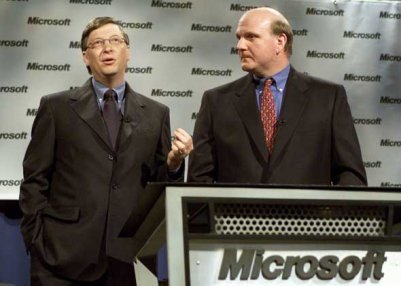
Back in the old days…
See Also:

Tablets May Be A No-Show At Windows Chief’s Talk In A Few Minutes

Windows 8 Will Be Two Operating Systems In One

Here Are The First Official Pictures Of Windows 8 For Tablets — And They Look Pretty Cool
Last fall, Steve Ballmer said that Windows 8 was Microsoft’s riskiest product ever. He wasn’t kidding.
We’ve only seen a demo — there’s no reliable word on when it will ship, what the tablets that use it will look like, or even how much of the demo was prototype versus actual code in the current build.
But based on that demo, Microsoft is taking its biggest step forward in more than 20 years, when it pushed Windows as the replacement for DOS.
The last time Apple was a competitor to Microsoft was the early 1990s. Apple lovers argued (and still do) that the Mac operating systems of the time were far more elegant and cleaner. Windows, at first, was just a layer on top of DOS.
Turns out, that’s what a lot of people wanted. Particularly businesses, which had a lot of investments in DOS software. (Games were another reason — games written for DOS tended to exploit the hardware better.)
Microsoft eventually phased out DOS completely — Windows XP was based on the newer Windows NT kernel (originally designed for servers). But the process took about 15 years.
Now it’s doing the same thing with Windows 8.
The immersive touch-optimized layer of Windows 8 that Microsoft demonstrated last night looks and feels completely different than the icons-on-a-desktop that have been around since the 1980s. It uses a different application programming model — basically, HTML5 and JavaScript, which are used for Web apps today.
But underneath that layer is the old Windows that users are accustomed to. It will run old Windows apps (at least on Intel-based machines). If the apps aren’t optimized for touch, that’s OK too — just run them in the old interface with a keyboard and mouse.
It’s exactly the opposite approach that Apple took with iOS, where it made a clean break with Mac OS.
A lot of Apple fans have argued that Microsoft’s approach will fail miserably. You can’t pack a post-PC experience in an old PC shell.
But there are some reasons why history could repeat itself:
- Platform changes are expensive for businesses. As users bring their iPads and other devices to work, businesses have to figure out how to make applications available to them. Should they rewrite everything to be Web-based and accessible through a browser? Should they use a virtualization technology like Citrix? Let users download their own apps and reimburse them? They also have to deal with security, management (like pushing out software updates) and other changes. With a Windows 8 tablet, the changes will be much less jarring.
- Consumer choice wins out in the long run. Right now, the iPad is the only tablet that’s selling. But other companies can make nice hardware — the Samsung Galaxy Tab 10.1 is a beautiful tablet burdened by some just-OK software (Android Honeycomb 3.0). More choice means more chances that a consumer will find the exact tablet they want.
- Price. Letting hardware makers compete also tends to drive prices down. It worked with DOS and Windows versus the early Macs, and it’s working now with Android phones — despite being first and offering a better experience in a lot of ways, the iPhone is now behind Android in market share. It’s hard for one phone to compete against hundreds.
There are still plenty of ways Microsoft could screw this up.
Windows 8 probably won’t be out for another year at least, maybe 18 months, giving competitors a ton of time to improve — particularly Google’s Android tablets, but also dark horses like Chromebooks or HP’s WebOS tablets.
Tablets based on ARM designs are apparently not going to run Intel-based Windows apps, eliminating a big benefit of running Windows in the first place.
The experience of switching between the old and new Windows interfaces could be clunky and confusing.
But at least nobody can accuse Microsoft of ignoring the tablet market.
In the past, Microsoft has often talked about “bet the company” initiatives, like the .NET programing model introduced a decade ago.
In this case, it actually IS betting the company. Windows earns between $12 and $14 billion a year on around $20 billion in sales. This isn’t messing around on the margins. This is playing with the crown jewels.
Adapt or die.
See also: Ballmer HAD To Make Windows The Center Of Microsoft’s Tablet Strategy.
Article source: SAI http://feedproxy.google.com/~r/typepad/alleyinsider/silicon_alley_insider/~3/O5vygvlLU2Q/windows-8-is-the-biggest-change-for-microsoft-since-windows-was-invented-2011-6